Mastering the Art: Unleash How to Grow Indoors Easily
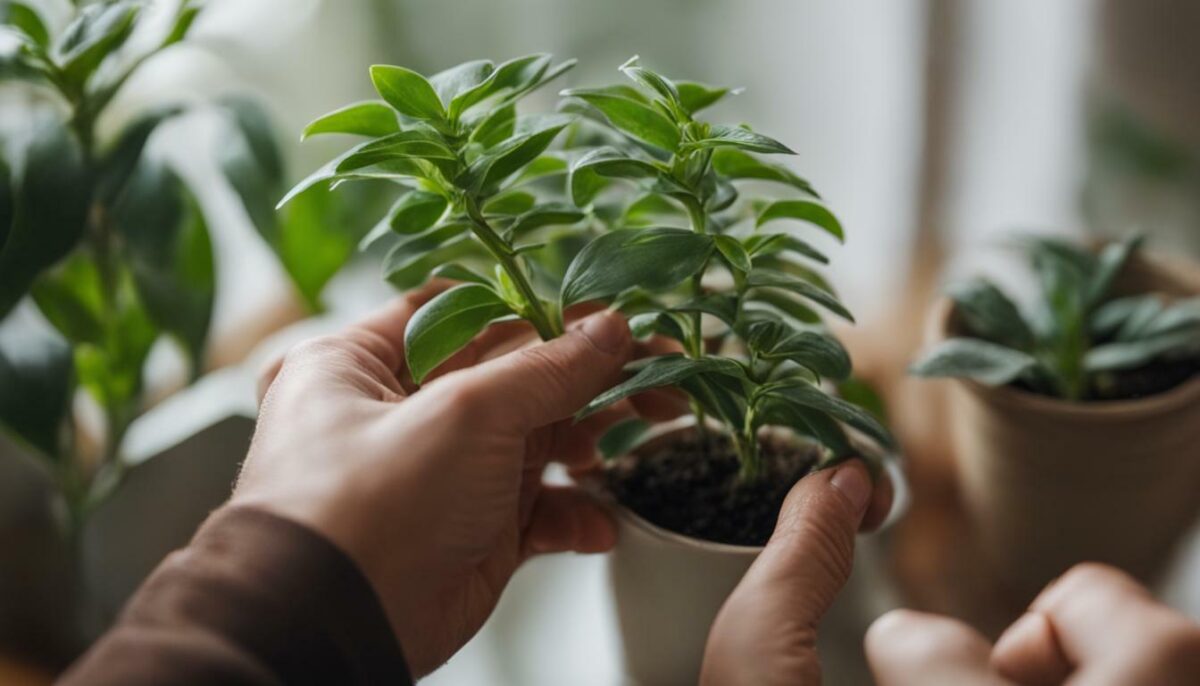
Growing plants indoors can be a rewarding and fulfilling experience – not only do indoor plants improve air quality and bring life to your home, but they can also reduce stress and boost your mood. However, if you’re new to indoor plant care, it can be daunting to figure out where to begin. That’s why in this section, I’m going to explore the art of growing plants indoors and share easy techniques and tips to create a beautifully green home using indoor plants.
- Indoor plants can improve air quality and reduce stress.
- Proper indoor plant care begins with understanding the basics of plant growth.
- Choosing the right seeds and soil, understanding lighting and humidity requirements, and providing proper air circulation and space are essential for success.
- Watering and nutrient management are crucial for healthy plant growth, while pest and disease prevention and identification are key for long-term success.
- Maximizing space and size management, choosing the right equipment, and properly harvesting and caring for your indoor plants are all important factors to consider.
Setting Up Your Indoor Grow Space
Growing plants indoors can be a rewarding and fulfilling experience, but before you start, it’s important to set up the right environment. Whether you’re a beginner or experienced grower, the success of your indoor garden depends on factors such as seeds, soil, lighting, humidity, air circulation, space, and water. Here are some tips to help you create the perfect indoor grow space:
Seeds and Soil
Choosing the right seeds and soil is essential for healthy plant growth. Start with high-quality seeds and ensure that the soil is nutrient-rich and well-draining. Avoid over-watering as this can lead to soil compaction and root rot.
| Tip: | Consider using a seed-starting mix to give your seedlings a healthy start. |
|---|
Lighting and Humidity
Light is crucial for indoor plant growth, but it’s important to understand the different types of lights available and their ideal placement. Consider investing in full-spectrum LED grow lights that mimic natural sunlight. Humidity levels also play a critical role in plant growth. Monitor humidity levels and use a humidifier if necessary to maintain the ideal range.
Air Circulation and Space
Proper air circulation and space are key to preventing common issues such as mold, mildew, and pests. Ensure proper ventilation and use fans to improve air circulation. Ensure that your plants have enough space to grow and develop.
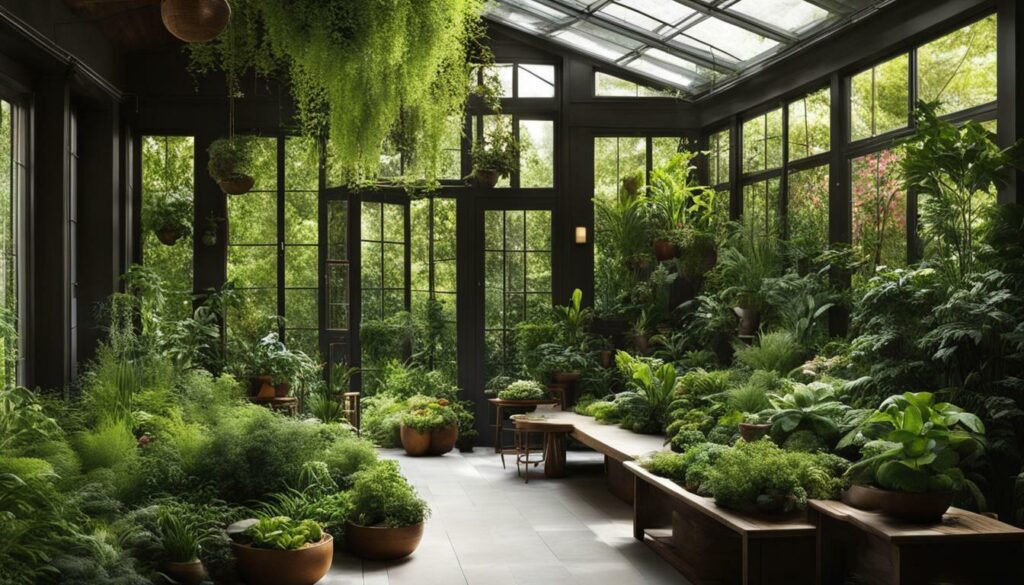
Proper watering is essential to ensure your plants maintain optimal growth. Water your plants when the soil is dry, but avoid over-watering as this can cause root rot. Use a watering can or drip system for precise watering.
Conclusion
By following these tips, you can set up a healthy and thriving indoor grow space. Remember to monitor and adjust environmental factors regularly to ensure the best possible growing conditions for your plants.
The Importance of Light and Temperature Control
As an indoor grower, it’s crucial to understand the importance of controlling light and temperature to promote optimal plant growth. Light is essential for photosynthesis, the process by which plants convert light into energy to fuel growth. Temperature also plays a significant role in plant growth and can affect the plant’s metabolism and flowering cycle.
When it comes to lighting, there are several options to choose from. LED lights are energy-efficient and emit minimal heat, making them a popular choice among growers. However, they can be more expensive upfront. Fluorescent lights are more affordable but emit more heat and may not be suitable for larger grow spaces. High-pressure sodium (HPS) lights are another option known for promoting flowering and top growth.
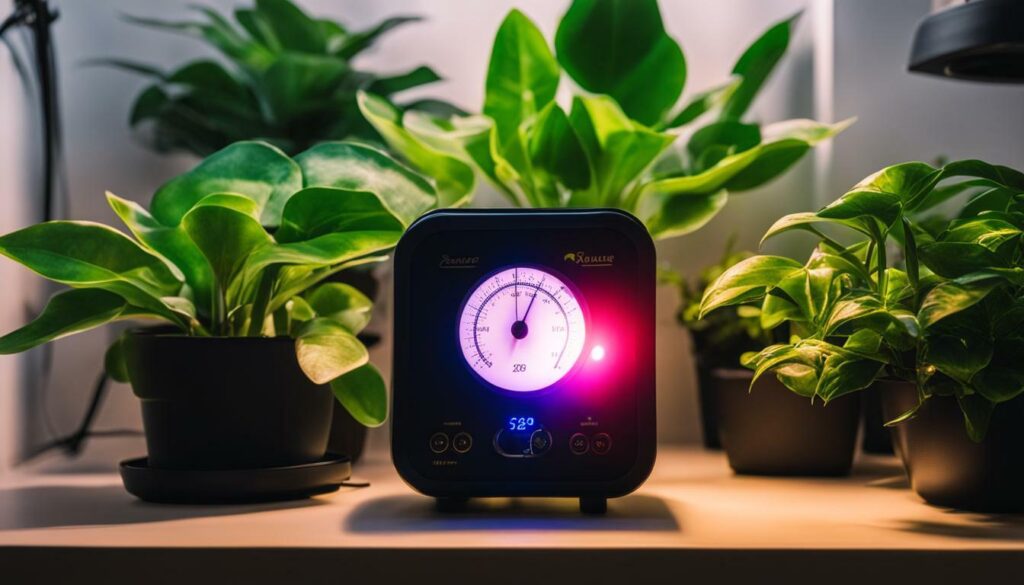
Temperature is another critical factor in indoor plant growth. Most plants thrive in temperatures between 65-75°F during the day, with a drop to around 55-65°F at night. However, some plants may have different temperature requirements, so it’s essential to research your specific strain.
It’s also important to create a suitable environment for your plants to thrive. Proper ventilation is crucial to prevent mold and mildew growth, which can be detrimental to plant health. Consider using fans to ensure adequate air circulation.
To summarize, lighting and temperature control are essential for optimal indoor plant growth. Consider your specific strain’s requirements when choosing lighting and maintain appropriate temperature ranges. Proper ventilation is also crucial to support healthy plant growth.
Watering and Nutrient Management
Proper watering and nutrient management are essential for healthy plant growth. As a grower, I’ve learned that every plant requires different amounts of water and nutrients depending on their size, growth stage, and surrounding environment.
First, let’s talk about watering your plants. Overwatering can lead to root rot, while underwatering can cause wilting and stunted growth. The key is to find the right balance. I recommend checking the moisture level of the soil regularly using a moisture meter or by sticking your finger about an inch deep into the soil. If it feels dry, it’s time to water your plant. Be sure to use room temperature water, as cold water can shock the roots.
When it comes to nutrients, it’s important to choose the right medium for your plants. Some plants prefer soil, while others thrive in hydroponic systems. Your nutrient management process will vary based on the type of medium you choose.
For soil-based indoor plants, I recommend using a high-quality potting mix that contains essential nutrients like nitrogen, phosphorus, and potassium. You can also supplement with organic fertilizers for more specific needs. It’s important to follow the instructions on the label carefully, as over-fertilizing can be harmful to your plants.
If you’re growing hydroponically, you’ll need to add nutrients to your water solution. There are many hydroponic nutrient solutions available on the market, each tailored to specific growth stages and plant types. Be sure to follow the manufacturer’s instructions and monitor your plants closely for any signs of nutrient deficiencies.
The roots and leaves of your plants can also tell you a lot about their nutrient health. Yellowing leaves may indicate a nitrogen deficiency, while stunted growth could mean a lack of phosphorus. Keep an eye out for these signs and adjust your nutrient management process accordingly.
Remember, proper watering and nutrient management are essential for healthy indoor plant growth. By understanding the process and keeping a close eye on your plants, you can ensure that they receive the right amount of water and nutrients to thrive.
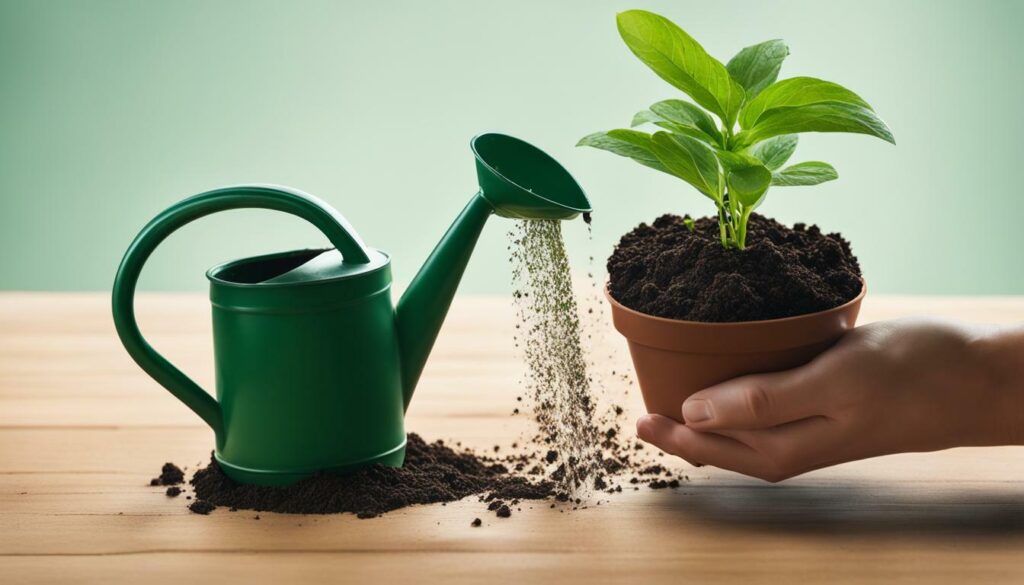
As a grower, it’s important to keep an eye out for pests and diseases that can harm your indoor plants. These issues can arise from a variety of sources, including soil, seedlings, or even the moisture in the air. To prevent these threats, it’s crucial to have good ventilation, keep your grow area clean, and take preventative measures to avoid infestations.
One of the most common pests in indoor gardening is the spider mite. These tiny creatures can quickly infest your plants, leading to yellowing leaves and stunted growth. To spot a spider mite infestation, look for small webs or white, cottony spots on the leaves. Another common pest is the fungus gnat, which feeds on the plant’s roots and can cause wilting. To prevent these pests, use a good-quality soil and avoid overwatering.
Ventilation and Airflow
Good ventilation is key to preventing pests and diseases in your indoor garden. Ensure your grow room has adequate airflow to remove excess moisture and prevent the spread of unwanted organisms. Consider using an oscillating fan to keep air moving throughout your grow space.
In addition to pests, indoor plants can also experience various diseases, such as powdery mildew or root rot. Powdery mildew appears as a white, powdery substance on the leaves, while root rot causes the plant to wilt and can lead to death. To prevent these diseases, keep your grow area clean and free from debris, and avoid overwatering your plants. It’s also important to select disease-resistant strains and use clean tools when handling your plants.
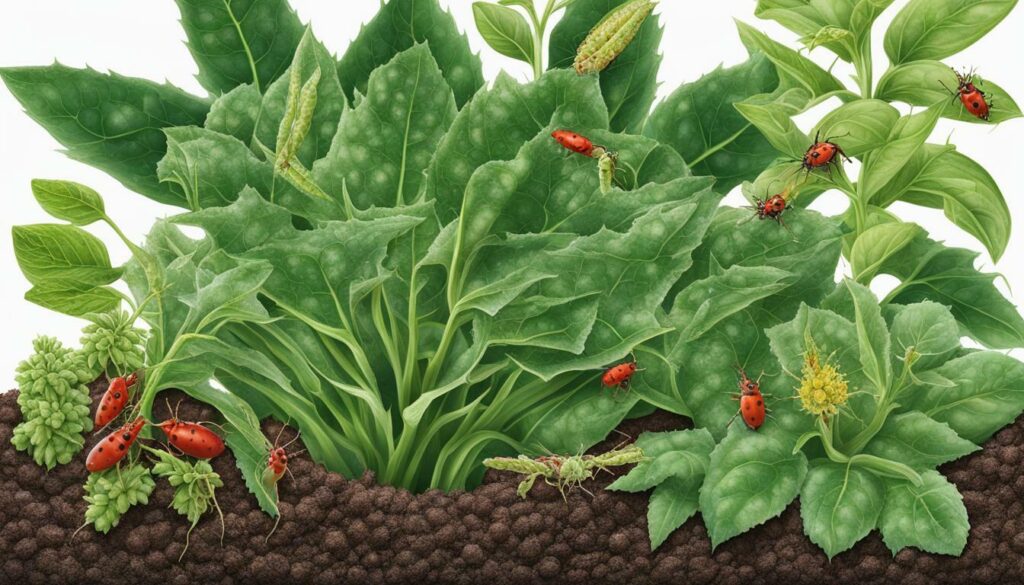
By taking proactive steps to prevent and manage pests and diseases in your indoor garden, you can ensure healthy and vibrant plants. Regular monitoring and attention to detail are key to success as an indoor grower. Happy gardening!
Maximizing Space and Size Management
As a grower, managing your indoor grow space is crucial to achieving the best results. Whether you have a lot of room or just a little, it’s important to make the most of the available space. One effective technique is to train your plants to grow horizontally using the low-stress training (LST) method. This encourages lateral growth and helps to create a more even canopy, which promotes optimal light absorption and bud development.
Another technique is to top your plants (removing the uppermost part of the stem) to encourage bushier growth and prevent them from growing too tall. If you’re short on space, consider using small pots or a vertical growing setup to maximize vertical space.
Flowering plants can take up a lot of space, so if you’re limited in that regard, consider using shorter growing strains that don’t stretch as much during the flowering cycle. Additionally, be sure to plan your grow space carefully to allow for adequate airflow and prevent overcrowding, which can lead to mold and mildew issues.
One final tip – remember that a little goes a long way when it comes to fertilizers and nutrients. Overfeeding your plants can lead to nutrient burn and other issues that stunt growth and reduce yield.
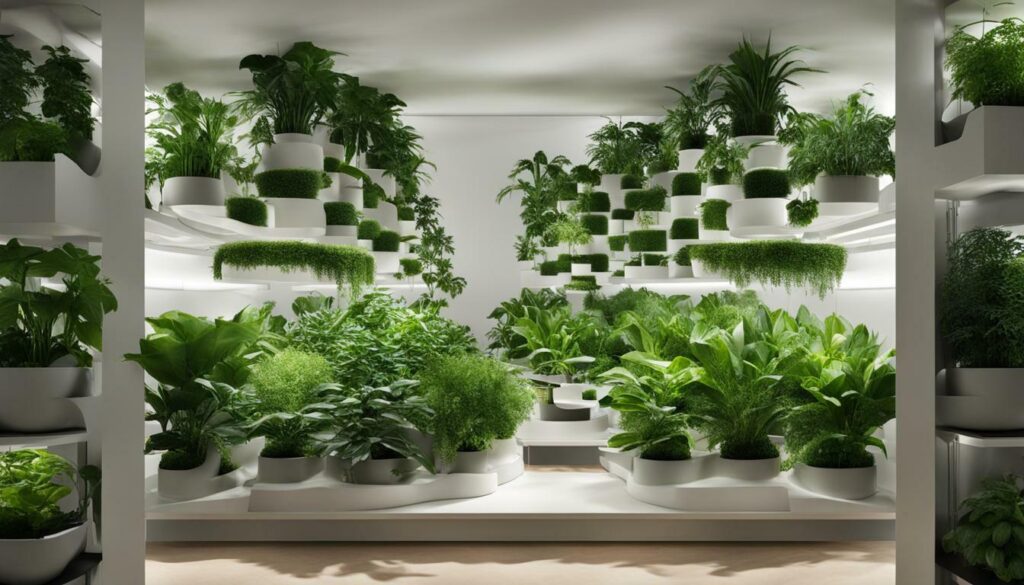
Choosing the right equipment is crucial to maximizing your space and achieving the best results. Look for compact LED lights or other grow lights designed for smaller spaces, and invest in a quality ventilation system to keep your grow space cool and well-circulated.
Consider using a grow tent or other enclosed space to maintain optimal environmental conditions and create a more controlled growing environment. With a little planning and the right equipment, you can create a thriving indoor garden no matter the size of your space.
Choosing the Right Equipment and Setup
When it comes to indoor growing, selecting the right equipment and setting up your grow space is crucial, whether you are a beginner or an experienced grower.
Lights are one of the most important pieces of equipment for indoor growing. LED grow lights are popular among growers because they are energy-efficient and emit full-spectrum light, which is essential for plant growth. Other options include fluorescent and HID (High-Intensity Discharge) lights.
Proper ventilation is also crucial when it comes to indoor growing. A good ventilation system will control temperature, humidity, and keep the air circulating throughout the grow space.
For beginners, setting up a flowering tent is a great way to start. A flowering tent is a small indoor growing space that can be set up with minimal equipment and is ideal for growing flowering plants. It’s important to choose a grow tent that is the right size for your needs and fits in the space you have available.
When it comes to harvesting, you will need a few essential tools, including a sharp pair of scissors or pruning shears, a magnifying glass, and a microscope. These tools will help you determine when your plants are ready for harvest and ensure that the process is done smoothly and efficiently.
No matter what equipment you choose, always keep in mind that it should be suitable for your specific needs and within your budget. With the right equipment and setup, you can achieve optimal growth, flowering, and harvest results for your indoor plants.
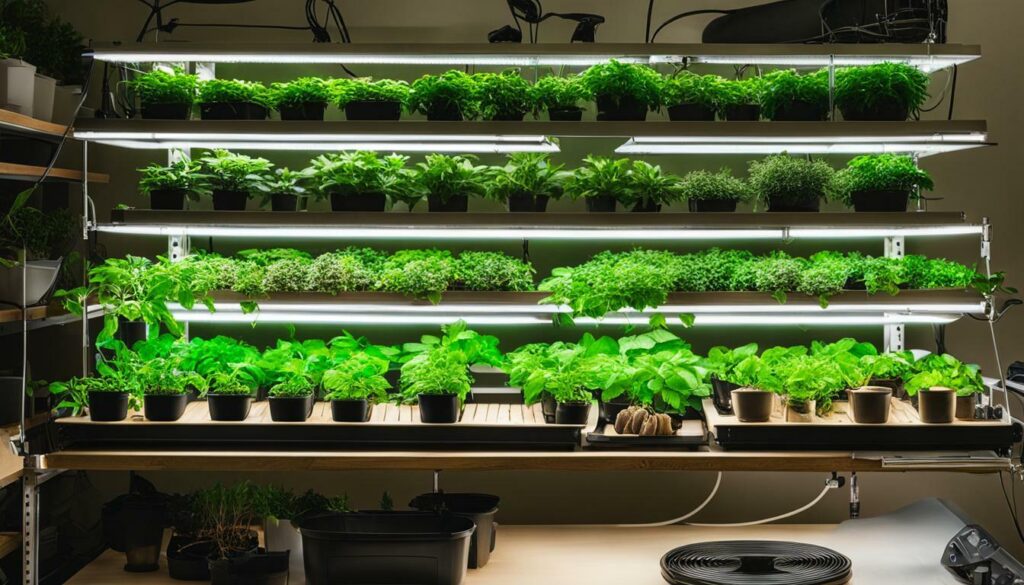
Now that your indoor plants have gone through their flowering cycle, it’s time to harvest and care for them properly. Choosing the right strain for your indoor garden is crucial in getting the best possible harvest. After all, different strains have unique characteristics that can significantly affect the outcome of your harvest.
The timing of your harvest is also vital. You can use a microscope to inspect the trichomes on the buds and determine the optimal time for harvesting. Once you’ve harvested your plants, you need to trim the leaves and hang them to dry in a well-ventilated area for about a week. During this period, make sure to maintain a humidity level of around 50-60% to ensure the best possible drying process.
After drying, it’s time to cure your buds. This process involves storing them in airtight containers, which will slowly break down any remaining chlorophyll while enhancing the buds’ flavor and aroma. Regularly check and open the containers to release any excess moisture and allow fresh air to circulate.
Now, let’s talk about plant care. Caring for your indoor plants is essential to ensure their longevity and health. One of the most critical factors in plant care is photosynthesis. This process is when plants convert light into energy, and nutrients fuel their growth and development. Understanding the importance of providing adequate light and nutrients is key to maintaining a healthy plant.
Regularly check the pH levels of the soil and water and make sure to adjust them when necessary. Make sure to water your plants only when the top layer of soil has dried out, and avoid over-watering, which can cause root rot. Additionally, ensure proper ventilation, and keep an eye out for pests and diseases that could affect your plants.
Overall, proper strain selection, harvesting, and care are crucial factors in achieving a healthy indoor garden. By following these techniques and tips, you’ll be able to enjoy a bountiful harvest and a thriving indoor garden. Happy growing!
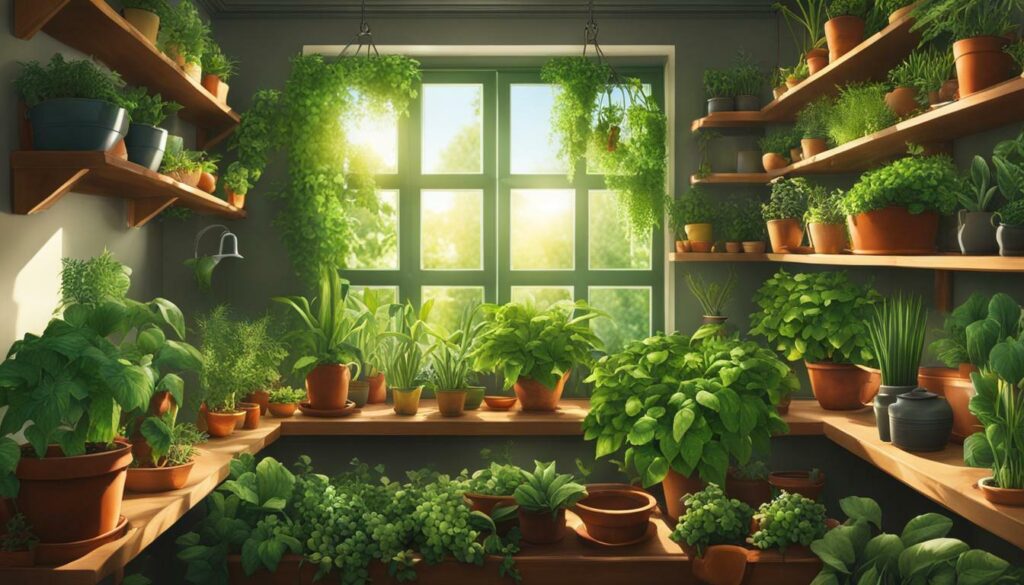
As I wrap up this article, I hope you’ve gained valuable insights into how to grow indoor plants successfully. Whether you’re a seasoned grower or a beginner, these tips and techniques can help you create a thriving garden in the comfort of your own home.
Remember, setting up the right environment is crucial for indoor plant growth. From choosing the right seeds and soil to understanding lighting and temperature requirements, every step counts towards a healthy garden.
Watering and nutrient management are just as important for healthy plant growth. Be mindful of the watering process and pick the right medium and nutrients for optimal growth.
As a grower, pests and diseases can be an unwelcome challenge, but with the right knowledge, you can prevent and treat them effectively. Ventilation is crucial to ensure a healthy environment for your plants, so be sure to monitor it closely.
Indoor gardening often requires maximizing available space, and you can achieve this by controlling the size of your plants and promoting optimal flowering.
Choosing the right equipment and setting up your indoor grow space is essential. Selecting the right tools, lights, ventilation, and other equipment can influence the quality of your harvest.
Finally, once the flowering cycle is complete, you must harvest your plants correctly and care for them properly to ensure longevity.
To sum it all up, growing plants indoors can be a fulfilling and rewarding experience that can bring the beauty of nature into your own home. With the tips and techniques in this article, you’ll be well on your way to mastering the art of growing indoor plants. Happy growing!
FAQ
Q: How do I choose the best seeds and soil for indoor gardening?
A: When choosing seeds, look for varieties that are well-suited for indoor growing. For soil, opt for a well-draining potting mix specifically formulated for indoor plants.
Q: What lighting and humidity requirements should I consider for my indoor plants?
A: Different plants have varying lighting and humidity needs. Research the specific requirements for your plants and provide them with the appropriate amount of light and humidity.
Q: How can I create the ideal environment for my indoor plants to thrive?
A: Ensure your plants receive adequate light, maintain the right temperature, provide proper ventilation, and avoid extreme fluctuations in environmental conditions.
Q: What is the best way to water indoor plants?
A: Water indoor plants when the top inch of soil feels dry to the touch. Water thoroughly, allowing excess water to drain out of the pot. Avoid overwatering as it can lead to root rot.
Q: How do I prevent and control pests and diseases in my indoor garden?
A: Implement proper ventilation, regularly inspect your plants for signs of pests or diseases, and take appropriate measures such as using organic pest control methods or seeking professional advice.
Q: Can I control the size of my indoor plants?
A: Yes, you can control the size of indoor plants through techniques like pruning, training, and using appropriate pot sizes. This will help manage space and encourage optimal growth.
Q: What equipment do I need to set up an indoor grow space?
A: Essential equipment for indoor growing includes grow lights, fans for ventilation, a timer, and appropriate containers or pots. Research the specific requirements for your plants to determine the necessary equipment.
Q: How do I harvest and care for my indoor plants?
A: Harvest indoor plants at the right time by observing their flowering cycle. After harvest, provide proper care by maintaining the right light, temperature, and nutrient levels to ensure their continued health.